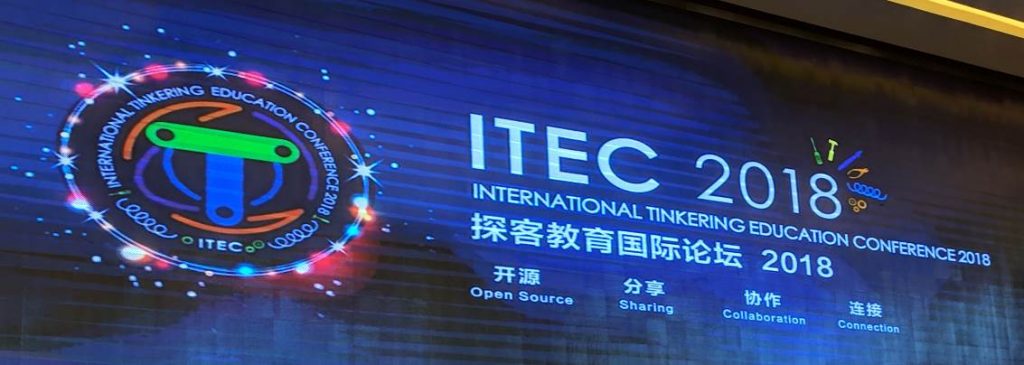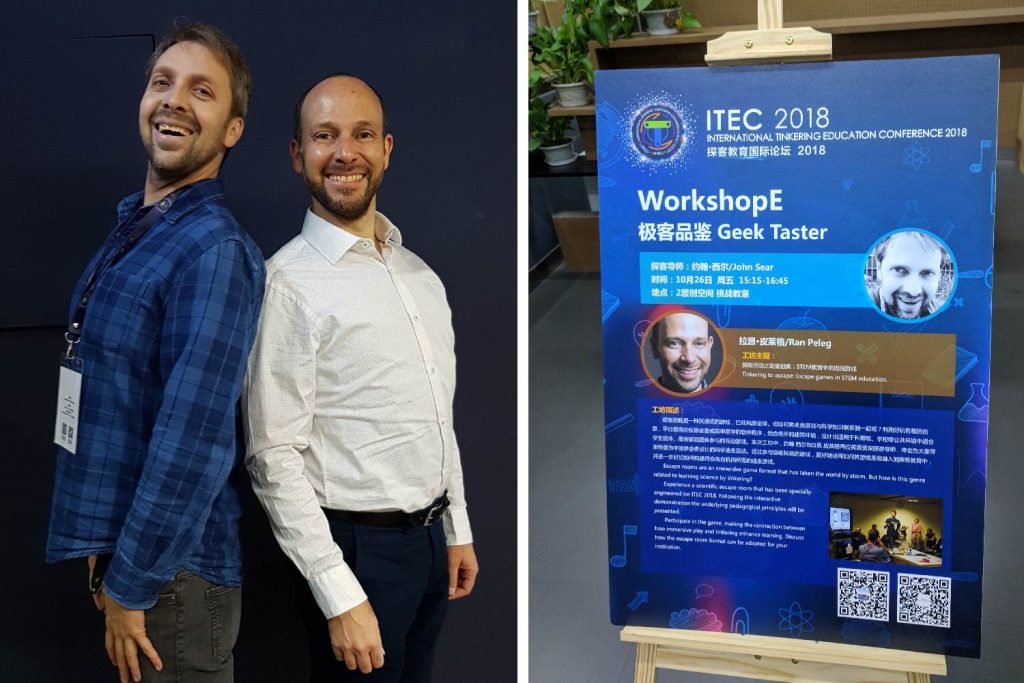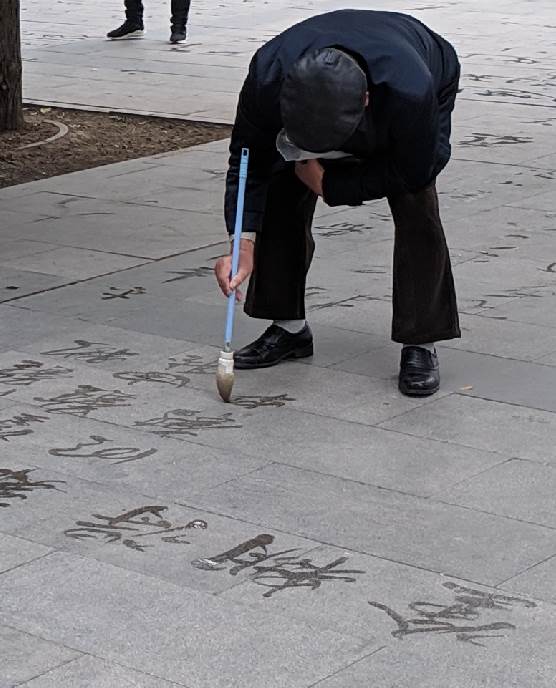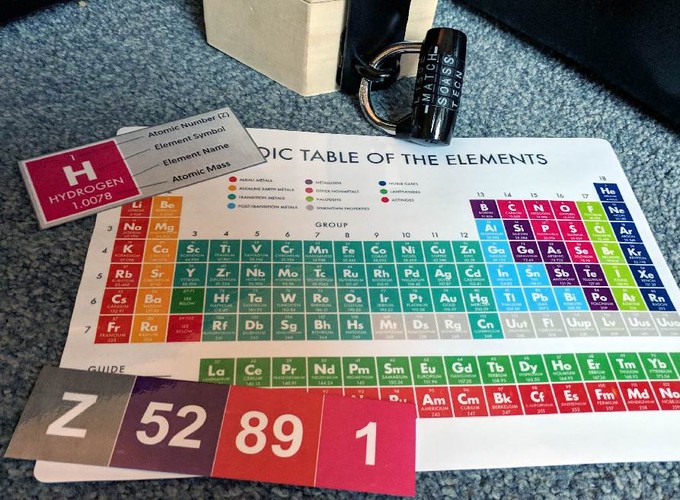International Tinkering Education Conference
I’ve been fortunate to be involved in the fantastic GEEK play & games festival 3 times now. Once at Dreamland in Margate, last summer at the Singapore Science Centre in (you’ve guessed it) Singapore and I’ve just come back from GEEK in Beijing! This time we were part of the inaugural – International Tinkering Education Conference at the Soong Ching Ling Science & Culture Center for Young People.

I partnered with the fantastic and delightful science communicator and game maker Ran Peleg. We’ve previously collaborated to create Escape Game workshops for Ecsite conferences in both Porto and Geneva. For Beijing we built a new Escape Game to showcase the power of collaborative games and puzzles for Science Communication and Tinkering.

The conference was attended by Science Educators and those from Science Museums across China. There’s a big overlap between Science Museums / Science Education and Tinkering / Maker Spaces with many Maker Spaces existing in Science Museums.
We created 10 different puzzles to showcase 10 different aspects of Science – to show that Escape Games could be used to get people excited about Science.

Stephane Berghmans of Technopolis in Belgium had my favourite analogy of the conference related to science to music: 90/9/1 rule.
- 90% are interested and listen to music
- 9% will be more engaged such as practising a musical instrument
- 1% will go on to use it as part of their careers
(It sounds similar to the 1% rule – used on Wikipedia – only 1% write new articles, 9% contribute and 90% lurk.)
Anyway – this is what we should aspire to at Science Museums getting 90% interested and intrigued by science. The goal of our Escape Game was exactly that to get people excited and intrigued by Science and leave them wanting to learn more.
The Concept
We went with a simple story and tried to stay away from the traditional bomb defusal / saving the world type experiences. We went with another popular variation that a person who loves puzzles has simply left you a variety of puzzles to solve. This works well when you have a wide variety of puzzles that are somewhat unrelated. As we’d built a showcase of puzzles this approach makes sense.
So our story is very much tied into the conference: The building’s automatic timer is about to kick in shutting down all the electricity to the entire building at 5pm. This isn’t normally a problem but tonight is the big dinner for the Inaugural International Tinker Education Conference with over 300 VIP guests attending.
Unfortunately the Head of Maintenance is nowhere to be seen. However, she has left a series of challenges that if they can be solved the power shutdown can be overridden and the dinner can take place.
We even tried to add our own bit of drama to the experience but starting the workshop as if it was us talking about Escape Games instead of playing them. During our presentation we organised for the lights to go out and a concerned member of the conference team rush in and explain what was going on.
The Game
The game was designed for 30 players split into 4 teams with each assigned a colour. Each team has the same set of challenges but with different solutions. Every object in the room has a small coloured sticker on it – so when you find it you know whether it belongs to your team. The immediate objects are placed on your team’s table – with others hidden in cupboards and on shelves around the room. A number of objects in the room are shared between all teams. And a number of puzzles are ‘cross-contaminated’ – so teams find pieces in their collections which they need to give to other teams. This is to encourage a bit of collaboration between teams.
While it was limited to 30 players we had many more come in to spectate for periods of the game. Although many spectators couldn’t resist contributing.
Technology
As it was also a Tinkering workshop we used a number of DIY pieces of technology.
- Story-elements and hints were delivered by Near Field Communication (NFC) cards. You can see how to do this in my Babbling Beasts tutorial. We also used the NFC cards to unlock a puzzle involving a list of famous scientists
- A PowerPoint interactive on a large screen was used so that each team could enter the final codes. Once the correct code was entered by all teams a success video was launched. PowerPoint is a surprisingly versatile tool for creating password protected content as you are able to program your own behaviour using Visual Basic for Applications (I spent a summer writing VBA as an intern – some 20 years ago – but it’s relatively straight-forward)
- Portable screens with their polarised filters removed. This means that clues could be delivered via these screens once players had found polarised glasses and figured out their use
- Ultra violet torches to uncover hidden clues
- Use of lead in a pencil to connect a circuit to reveal a number
It was very much about showing what could be made and then encouraging people to make their own.
Mandarin Chinese
So this is the first of my games that I’ve translated into Mandarin! It was apparent very early on that even though we’d reduced and simplified the use of language in all our puzzles – the attendees to the conference would really struggle with the language. (They were reasonably comfortable our Western Arabic numeral system so we’d used that with some of the puzzles). We were lucky enough to have Mint Lui, one of the employees of Star Group, with excellent English Skills help with the translation, act in the video and voice the character of the Head of Maintenance.
Results
The game was a huge success. I think our bit of drama at the beginning helped to get the attendees in the mood. And even though the majority of the players had never tried a commercial escape room they got into the swing of the game immediately.

There was a great atmosphere in the room and the players only needed minor prompting from us as Game Hosts to keep things moving along.
The intention was to follow it up with a ‘making’ workshop however as the conference was running behind schedule this was trimmed down considerably to a short wrap-up talk. Including directions to my free online guide to creating your own Escape Game with free android app.
Bonus Beijing Observations
As we were guests of Star Group, a Chinese company that specialises in the build of Science Museum Exhibitions, we received incredible hospitality throughout. Once we’d finished working we went on a number of tours of the city sights and taken out for many delicious meals J
As this was my first trip to Beijing here’s a few of Beijing related takeaways (I doubt I am the first to make any of these observations!):
- Beijing is a ridiculous-sized city – that has been growing at an incredible rate. Obviously, it’s already the largest capital city on earth but seeing the scale of it in person is quite something.
- Traveling anywhere by road is an ‘experience’. Millions of cars, buses, bikes, mopeds, three-wheeled trucks all share the same space and no one gives an inch. Crossing the road as a pedestrian is an extreme sport – pedestrians are the lowest form of traveller. If we manage to solve self-driving vehicles for Beijing then the rest of the world will be a piece of cake!
- Business relationships takes time to establish. You need many visits to build relationships and take part in the business relationship ‘dance’.
- English isn’t that widely spoken. So I guess we’re all learning Mandarin in our post-Brexit world.
- They have some fantastic food and I loved the collaborative eating style (everything is ordered for the table to share) – even though I am an absolute amateur at using chopsticks
- WeChat is everything. We’ve all heard that – but seeing it in action is amazing. Everything happens on WeChat. To the point that if you don’t have WeChat you can’t take part in modern life.
- QR codes are everywhere. It’s how you share your WeChat identity with people (instead of swapping business cards), it’s how you pay for things. You can leave your wallet at home but not your phone.
- The Great (Fire) Wall of China is real. There is zero chance of accessing anything Google, BBC, reddit, whatsapp, facebook etc. You’ll need a decent VPN to get around it – and you should probably install it before you go there as many VPN sites are blocked. Not all will work as China was cracked down on these recently (they take a bit of a blind-side of it since many international companies need to use blocked sites to conduct business). ExpressVPN was one that worked best for me and I could install it inside China.
- Voice messaging is really popular. Instead of text messaging people leave voice messages for each other. It’s much quicker to leave a voice message than to write the message using pinyin Mandarin Chinese.
- My favourite moment was seeing retired people out and about early morning in the local parks. It turns out that the age of retirement for women in China is either 50 or 55 years old depending on whether you are a civil servant! Just next to our hotel was a huge park and lake which was full of thousands of retirees taking part in all manner of group outdoor activites – Tai Chi, Singing, Playing instruments, Ballroom dancing, Meditive Water Calligraphy etc!

Huge thanks
Huge thanks to Kate Kneale (and her team at HKD) who assembled the UK gamemakers and artists, and to everyone at Star Group especially CEO Yule Zhang who invited us to be part of his Tinkering Conference. Wonderful to hang out with the other UK Artists Genetic Moo (who have also shared photos of our time together) and others from further afield: Frank Kusiak, Ryan Jenkins, Olle Bjerkas & Stephane Berghmans. We had a fabulous time and hopefully we’ll all be back in Beijing to collaborate with our new friends in the near future!
